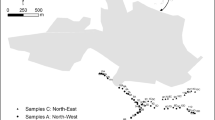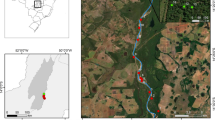Abstract
Ninety-five wild forage plants (belonging to 22 species of 18 families) and their corresponding rhizosphere soil samples were collected from wastelands of a large-scale abandoned Hg mining region for total Hg (THg) and methylmercury (MeHg) analysis. The forage plant communities on the wastelands were dominated by the Asteraceae, Crassulaceae, and Polygonaceae families. The THg and MeHg concentrations in the forage plants varied widely and were in the range of 0.10 to 13 mg/kg and 0.19 to 23 μg/kg, respectively. Shoots of Aster ageratoides showed the highest average THg concentration of 12 ± 1.1 mg/kg, while those of Aster subulatus had the highest average MeHg concentrations of 7.4 ± 6.1 μg/kg. Both the THg and MeHg concentrations in the aboveground plant parts exhibited positive correlations with the THg (r = 0.70, P < 0.01) and MeHg (r = 0.68, P < 0.01) concentrations in the roots; however, these were not correlated with the THg and MeHg concentrations in their rhizosphere soils. The species A. ageratoides, A. subulatus, and S. brachyotus showed strong accumulation of Hg and are of concern for herbivorous/omnivorous wildlife and feeding livestock. Taking the provisional tolerable weekly intake (PTWI) values for IHg recommended by the Joint FAO/WHO Expert Committee on Food Additives (JECFA in Summary and conclusions of the seventy-second meeting of the joint FAO/WHO expert committee on food additives Rome, Italy, 2010) for human dietary exposure of 4 ng/g into account, the daily intake of IHg by a 65 kg animal grazing on 1.0 kg of forage (dry weight) would be between 190 and 13,200 μg, three to five orders of magnitude higher than the permitted limit, suggesting a potential risk of exposure.






Similar content being viewed by others
References
Abeysinghe KS, Qiu G, Goodale E, Anderson CWN, Bishop K, Evers D, Goodale M, Hintelmann H, Liu S, Mammides C, Quan RC, Wang J, Wu P, Xu XH, Yang XD, Feng X (2017) Mercury flow through an Asian rice-based food web. Environ Pollut 229:219–228
Agency for Toxic Substances and Disease Registry (ATSDR) (2013) Addendum for organic mercury compounds (alkyl and dialkyl mercury compounds). Supplement to the 1999 toxicological profile for mercury, Atlanta. http://www.atsdr.cdc.gov/toxprofiles/mercury_organic_addendum.pdf
Basri B, Sakakibara M, Sera K (2020) Mercury in soil and forage plants from artisanal and small-scale gold mining in the Bombana area, Indonesia. Toxics 8(1):15–24
Conko KM, Landa ER, Kolker A, Kozlov K, Gibb HJ, Centeno JA, Panov BS, Panov YB (2013) Arsenic and mercury in the soils of an industrial city in the Donets Basin, Ukraine. Soil Sediment Contam Int J 22(5):574–593
Cosio C, Flück R, Regier N, Slaveykova VI (2014) Effects of macrophytes on the fate of mercury in aquatic systems. Environ Toxicol Chem 33(6):1225–1237
De Vries W, Schütze G, Lofts S, Meili M, Römkens P, Farret R, De Temmerman L, Jakubowski M (2003) Critical limits for cadmium, lead, and mercury related to ecotoxicological effects on soil organisms, aquatic organisms, plants, animals and humans. In: Background document for the “Expert meeting on critical limits for heavy metals and methods for their application”. Berlin 2–4 December 2002, held under the UNECE Convention on long range transboundary air pollution, pp 1–61
Driscoll CT, Mason RP, Chan HM, Jacob DJ, Pirrone N (2013) Mercury as a global pollutant: sources, pathways, and effects. Environ Sci Technol 47(10):4967–4983
GB2762-2017 (2017) National safety standards for foods and maximum levels of contaminant in foods. Ministry of Health of the People’s Republic of China
Gibb H, Haver C, Kozlov K, Centeno JA, Jurgenson V, Kolker A, Conko KM, Landa ER, Xu H (2011) Biomarkers of mercury exposure in two eastern Ukraine cities. J Occup Environ Hyg 8(4):187–193
Gonzaga MIS, Santos JAG, Ma LQ (2008) Phytoextraction by arsenic hyperaccumulator Pteris vittata L. from six arsenic-contaminated soils: repeated harvests and arsenic redistribution. Environ Pollut 154(2):212–218
Gramss G, Voigt K (2014) Forage and rangeland plants from uranium mine soils: long-term hazard to herbivores and livestock? Environ Geochem Health 36:441–452
Gray JE, Hines ME, Biester H (2006) Mercury methylation influenced by areas of past mercury mining in the Terlingua district, Southwest Texas, USA. Appl Geochem 21(11):1940–1954
Horvat M, Nolde N, Fajon V, Jereb V, Logar M, Lojen S, Jacimovic R, Falnoga I, Qu L, Faganeli J, Drobne D (2003) Total mercury, methylmercury and selenium in mercury polluted areas in the province Guizhou, China. Sci Total Environ 304(1–3):231–256
JECFA (2010) Summary and conclusions of the seventy-second meeting of the joint FAO/WHO expert committee on food additives Rome, Italy
Liang L, Horvat M, Cernichiari E, Gelein B, Balogh S (1996) Simple solvent extraction technique for elimination of matrix interferences in the determination of methylmercury in environmental and biological samples by ethylation-gas chromatography-cold vapor atomic fluorescence spectrometry. Talanta 43(11):1883–1888
Lin LY, Chang LF, Jiang SJ (2008) Speciation analysis of mercury in cereals by liquid chromatography chemical vapor generation inductively coupled plasma-mass spectrometry. J Agric Food Chem 56(16):6868–6872
Lin Y, Larssen T, Vogt RD, Feng X (2010) Identification of fractions of mercury in water, soil and sediment from a typical Hg mining area in Wanshan, Guizhou province, China. Appl Geochem 25(1):60–68
Li Q, Li T, Qiu G, Liu C (2020) Total mercury and methylmercury in the soil and vegetation of a riparian zone along a mercury-impacted reservoir. Sci Total Environ 738:139794
Li Y, Zhao J, Guo J, Liu M, Xu Q, Li H, Li YF, Zheng L, Zhang Z, Gao Y (2017) Influence of sulfur on the accumulation of mercury in rice plant (Oryza sativa L.) growing in mercury contaminated soils. Chemosphere 182:293–300
Lu R (2000) Chemical analysis method of agricultural soil. China Agriculture Science Press, Beijing, pp 106–107
MacDonald D, Ingersoll C, Berger T (2000) Development and evaluation of consensus-based sediment quality guidelines for freshwater ecosystems. Arch Environ Contam Toxicol 39:20–31
Madejón P, Domínguez MT, Murillo JM (2012) Pasture composition in a trace element-contaminated area: the particular case of Fe and Cd for grazing horses. Environ Monit Assess 184(4):2031–2043
Marrugo-Negrete J, Marrugo-Madrid S, Pinedo-Hernández J, Durango-Hernández J, Díez S (2016) Screening of native plant species for phytoremediation potential at a Hg-contaminated mining site. Sci Total Environ 542:809–816
Meng B, Feng X, Qiu G, Liang P, Li P, Chen C, Shang L (2011) The process of methylmercury accumulation in rice (Oryza sativa L.). Environ Sci Technol 45:2711–2717
MH (2017) Ministry of Health of the People's Republic of China, Maximum levels of contaminants in foods. GB 2762-2017, Beijing, China
Peng H, Reid MS, Le Chris X (2015) Consumption of rice and fish in an electronic waste recycling area contributes significantly to total daily intake of mercury. J Environ Sci 12(38):83–86
Qian X, Wu Y, Zhou H, Xu X, Xu Z, Shang L, Qiu G (2018) Total mercury and methylmercury accumulation in wild plants grown at wastelands composed of mine tailings: Insights into potential candidates for phytoremediation. Environ Pollut 239:757–767
Qian X (2020) Tolerant plants and their accumulation mechanism of mercury in typical mercury mining areas. Dissertation, Guizhou University
Qiu G, Feng X, Meng B, Wang X (2012) Methylmercury in rice (Oryza sativa L.) grown from the Xunyang Hg mining area, Shanxi province, Northwestern China. Pure Appl Chem 84:281–289
Qiu G, Feng X, Wang S, Shang L (2005) Mercury and methylmercury in riparian soil, sediments mine-waste calcines, and moss from abandoned Hg mines in east Guizhou province, southwestern China. Appl Geochem 20(3):627–638
Schwesig D, Krebs O (2003) The role of ground vegetation in the uptake of mercury and methylmercury in a forest ecosystem. Plant Soil 253:445–455
Shi J, Liang LN, Jiang G (2005a) Simultaneous determination of methylmercury and ethylmercury in rice by capillary gas chromatography coupled on-line with atomic fluorescence spectrometry. J AOAC Int 88(2):665–669
Shi JB, Liang LN, Jiang GB, Jin XL (2005b) The speciation and bioavailability of mercury in sediments of Haihe River, China. Environ Int 31(3):357–365
Tang Z, Fan F, Wang X, Shi X, Deng S, Wang D (2018) Mercury in rice (Oryza sativa L.) and rice-paddy soils under long-term fertilizer and organic amendment. Ecotoxicol Environ Saf 150:116–122
Tong Y, Zhang W, Hu D, Ou L, Hu X, Yang T, Wei W, Ju L, Wang X (2013) Behavior of mercury in an urban river and its accumulation in aquatic plants. Environ Earth Sci 68(4):1089–1097
USEPA (2001) Method 1630: Methylmercury in water by distillation, aqueous ethylation, purge and trap, and CVAFS. EPA-821-R-01-020. Washington, DC
Wang J, Feng X, Anderson CWN, Qiu G, Li P, Bao Z (2011) Ammonium thiosulphate enhanced phytoextraction from mercury contaminated soil-results from a greenhouse study. J Hazard Mater 186(1):119–127
Xing D, Li R, Cao X, Liu H (2010) Heavy metal tolerance feature of Buddleja davidii in the indigenous zinc smelting area. J Mount Agric Biol 29:226–230 ((in Chinese))
Xu X, Meng B, Zhang C, Feng X, Gu C, Guo J, Bishop K, Xu Z, Zhang S, Qiu G (2017) The local impact of a coal-fired power plant on inorganic mercury and methyl-mercury distribution in rice (Oryza sativa L.). Environ Pollut 233:11–18
Xu X, Gu C, Feng X, Qiu G, Shang L, Xu Z, Lu Q, Xiao D, Wang H, Lin Y, Larssen T (2019a) Weir building: a potential cost-effective method for reducing mercury leaching from abandoned mining tailings. Sci Total Environ 651:171–178
Xu Z, Abeysinghe K, Xu X, Gu H, Liang L, Lu Q, Zhang Y, Zheng L, Wang W, Qiu G (2019b) New insights into the chemical forms of extremely high methylmercury in songbird feathers from a contaminated site. Chemosphere 225:803–809
Xu Z, Lu Q, Xu X, Feng X, Liang L, Liu L, Li C, Chen Z, Qiu G (2020) Multi-pathway mercury health risk assessment, categorization and prioritization in an abandoned mercury mining area: a pilot study for implementation of the Minamata Convention. Chemosphere 260:127582
Yoon J, Cao X, Zhou Q, Ma LQ (2006) Accumulation of Pb, Cu, and Zn in native plants growing on a contaminated Florida site. Sci Total Environ 368(2–3):456–464
Zhang H, Feng X, Larssen T, Shang L, Li P (2010) Bioaccumulation of methylmercury versus inorganic mercury in rice (Oryza sativa L.) grain. Environ Sci Technol 44(12):4499–4504
Zhang H, Fu X, Lin CJ, Shang L, Zhang Y, Feng X, Lin C (2016) Monsoon-facilitated characteristics and transport of atmospheric mercury at a high-altitude background site in southwestern China. Atmos Chem Phys 16:13131–13148
Zhao L, Qiu G, Anderson CWN, Meng B, Wang D, Shang L, Yan H, Feng X (2016) Mercury methylation in rice paddies and its possible controlling factors in the Hg mining area, Guizhou province, southwest China. Environ Pollut 215:1–9
Acknowledgements
Financial support for this work was provided by the talent introduction research project of Guizhou University (2019: 06), the National Key Research and Development Plan [2018YFC1802602], the First-Class Ecology Discipline in Guizhou Province (No. GNYL[2017]007), and the National Natural Science Foundation of China (NSFC: 41573135).
Author information
Authors and Affiliations
Corresponding authors
Ethics declarations
Conflict of interest
The authors declare that they have no conflict of interests or personal relationships that could have influenced the work reported in the manuscript.
Supplementary Information
Below is the link to the electronic supplementary material.
Rights and permissions
About this article
Cite this article
Qian, X., Yang, C., Xu, X. et al. Extremely Elevated Total Mercury and Methylmercury in Forage Plants in a Large-Scale Abandoned Hg Mining Site: A Potential Risk of Exposure to Grazing Animals. Arch Environ Contam Toxicol 80, 519–530 (2021). https://doi.org/10.1007/s00244-021-00826-2
Received:
Accepted:
Published:
Issue Date:
DOI: https://doi.org/10.1007/s00244-021-00826-2




